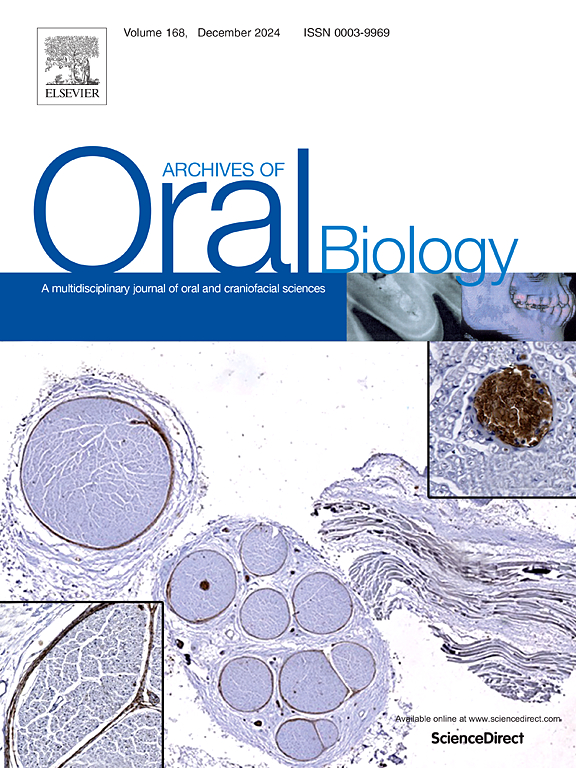col1相关重叠障碍:一种与单和双等位基因COL1A1/2变异相关的新表型
IF 2.1
4区 医学
Q2 DENTISTRY, ORAL SURGERY & MEDICINE
引用次数: 0
摘要
目的:我们描述了由单等位基因和双等位基因COL1A1/2变异引起的四个不相关家族的临床、放射学和口腔牙科的异常骨骼表型的发现。本研究纳入5例阿拉伯患者,临床表现类似成骨不全,伴有不同程度的骨质疏松症、骨畸形、灰色巩膜、颅骨虫状骨和口腔-牙齿异常。然而,骨折,被认为是成骨不全患者的主要特征,在任何病例中都没有记录。此外,他们也缺乏Ehlers-Danlos综合征的特征。外显子组序列用于鉴定致病变异。结果COL1A1: c.4340新纯合错义变异 T >; G;p.(Val1447Gly)在一个家族中被鉴定出来,而其余三个家族在COL1A2中有两个复发和一个新的杂合变异:[c.1171 G>;A;]p.(Gly391Ser)和C .1253 G>;C;p.(Gly418Ala)] and COL1A1: c.1678 G>;A;分别p。(Gly560Ser)。结论:与文献中报道的少数患者相比,我们提出了一种具有独特骨骼表型的纯合子COL1A1变异的新患者。此外,我们描述了三个具有单等位基因COL1A1/2变异的成骨不全样表型的家族,扩大了col1相关重叠疾病的谱。本文章由计算机程序翻译,如有差异,请以英文原文为准。
COL1-related overlap disorder: An emerging phenotype linked to mono- and bi-allelic COL1A1/2 variants
Objectives
We describe the clinical, radiological, and oro-dental findings of four unrelated families with unusual skeletal phenotypes caused by mono- and bi- allelic COL1A1/2 variants.
Design
The study included five Arab patients with clinical manifestations resembling osteogenesis imperfecta in the presence of variable degrees of osteoporosis, bone deformities, gray sclera, Wormian bones in the skull, and oro-dental abnormalities. However, bone fractures, which are considered the cardinal feature in osteogenesis imperfecta patients, were not documented in any of the cases. In addition, they also lacked the characteristic features of Ehlers-Danlos syndrome. Exome sequence was used to identify the causative variants.
Results
A new homozygous missense variant in COL1A1: c.4340 T > G; p.(Val1447Gly) was identified in one family, while the remaining three families harbored two recurrent and one novel heterozygous variants in COL1A2: [c.1171 G>A; p.(Gly391Ser) and c.1253 G>C; p.(Gly418Ala)] and COL1A1: c.1678 G>A; p.(Gly560Ser), respectively.
Conclusions
We present a new patient harboring a homozygous COL1A1 variant with a distinctive skeletal phenotype in comparison to the few previously reported patients in the literature. In addition, we describe three families with osteogenesis imperfecta like phenotype harboring monoallelic COL1A1/2 variants, expanding the spectrum of COL1-related overlap disorder.
求助全文
通过发布文献求助,成功后即可免费获取论文全文。
去求助
来源期刊

Archives of oral biology
医学-牙科与口腔外科
CiteScore
5.10
自引率
3.30%
发文量
177
审稿时长
26 days
期刊介绍:
Archives of Oral Biology is an international journal which aims to publish papers of the highest scientific quality in the oral and craniofacial sciences. The journal is particularly interested in research which advances knowledge in the mechanisms of craniofacial development and disease, including:
Cell and molecular biology
Molecular genetics
Immunology
Pathogenesis
Cellular microbiology
Embryology
Syndromology
Forensic dentistry
 求助内容:
求助内容: 应助结果提醒方式:
应助结果提醒方式:


